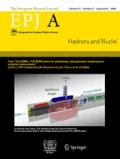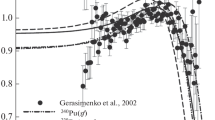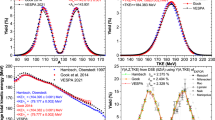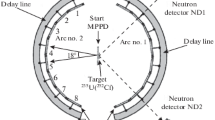Abstract
The present paper continues a recently published study (devoted to the influence of energy partition in fission and pre-neutron fragment distributions on post-neutron fragment yields) by the investigation of possible correlations between quantities characterizing the pre- and post-neutron fragments. An interesting correlation between the excitation energy of fully accelerated pre-neutron fragments and the kinetic energies of post-neutron fragments is found. The influence of both the energy partition in fission and the pre-neutron fragment distributions on the behaviour of the excitation energy of pre-neutron fragments as a function of the kinetic energy of post-neutron fragments is investigated, too.










Similar content being viewed by others
Data Availability Statement
This manuscript has no associated data or the data will not be deposited. [Authors' comment: All data generated during this work are included in the published paper.]
References
A. Tudora, Eur. Phys. J. A 58, 126 (2020)
A.Tudora, “Influence of pre-neutron fragment distributions Y(A,TKE) and energy partition in fission on independent FPY, application for 235U(nth,f)”, oral presentation #8 at the 15th International Conference on Nuclear Data for Science and Technology ND-2022, 21–29 July, 2022, Sacramento, USA.
A. Tudora, F.-J. Hambsch, I. Visan, G. Giubega, Nucl. Phys. A 940, 242–263 (2015)
C. Morariu, A. Tudora, F.-J. Hambsch, S. Oberstedt, C. Manailescu, J. Phys. G: Nucl. Part. Phys. 39, 055103 (2012)
R. Capote, Y.J. Chen, F.-J. Hambsch, N. Kornilov, J.P. Lestone, O. Litaize, B. Morillon, D. Neudecker, S. Oberstedt, N. Otuka, V.G. Pronyaev, A. Saxena, O. Serot, O.A. Scherbakov, N.C. Shu, D.L. Smith, P. Talou, A. Trkov, A.C. Tudora, R. Vogt, A.S. Vorobyev, Nucl. Data Sheets 131, 1–106 (2016)
A. Tudora, F.-J. Hambsch, Eur. Phys. J. A 53(8), 159 (2017)
A. Tudora, F.-J. Hambsch, V. Tobosaru, Eur. Phys. J. A 54(5), 87 (2018)
A. Tudora, Eur. Phys. J. A 55(6), 98 (2019)
A. Tudora, Eur. Phys. J. A 56(5), 128 (2020)
A. Tudora, Eur. Phys. J. A 56(3), 84 (2020)
M. Albertsson, Acta Physica Polonica 12, 499–506 (2019)
M. Albertsson, B.C. Carlsson, T. Døssing, P. Möller, J. Randrup, S. Åberg, Phys. Lett. B. 803, 135276 (2020)
M. Albertsson, B.C. Carlsson, T. Døssing, P. Möller, J. Randrup, S. Åberg, Phys. Rev. C 103, 014609 (2021)
P. Talou, I. Stetcu, P. Jaffke, M.E. Rising, A.E. Lovell, T. Kawano, Comput. Phys. Commun. 269, 108087 (2021)
S. Okumura, T. Kawano, P. Jaffe, P. Talou, S. Chiba, J. Nucl. Sci. Tech. 55(9), 1009–1023 (2018)
S. Okumura, T. Kawano, P. Jaffe, P. Talou, T. Yoshida, S. Chiba, Proceeding 150th Int. Conf. Nucl. Reactions Mechanisms, Varenna, Italy 11–15 June 2018
A.E. Lovell, T. Kawano, S. Okumura, I. Stetcu, R. Mumpower, P. Talou, Phys. Rev. C 103, 014615 (2021)
Ch. Straede, C. Budtz-Jorgensen, H.H. Knitter, Nucl. Phys. A 462, 85–108 (1987)
A. Al-Adili, F.-J. Hambsch, S. Pomp, S. Oberstedt, Phys. Rev. C 86(5), 054601 (2012)
K.-H.Schmidt, B.Jurado, GEF code version 2021.1.1, available on-line at http://www.khschmidts-nuclear-web.eu/GEF.html
K.-H. Schmidt, B. Jurado, C. Amouroux, C. Schmitt, Nucl. Data Sheets 131, 107–221 (2016)
A.C. Wahl, Atomic Data Nucl. Data Tables 38, 1–156 (1988)
EXFOR Experimental Nuclear Data Library (available online at https://www-nds.iaea.org) target nucleus U-235, reaction (n,f), quantity MFQ: entries 14369003 (Milton and Fraser), 30909004 (Boldeman), 21095002–004 (Maslin), 22464004 (Nishio), 41516012 (Vorobyev)
A. Göök, F.-J. Hambsch, S. Oberstedt, M. Vidali, Phys. Rev. C 98, 044616 (2018)
A. V. Ignatyuk, in IAEA-RIPL1-TECDOC-1034, Segment V, Chapter 5.1.4 (1998)
T. von Egidy, D. Bucurescu, Phys. Rev. C 80, 054310 (2009)
Database of mass excesses AME2020: https://www-nds.iaea.org/amdc/ (the file ‘mass_1.mas20.txt’ dated Mars 3, 2021)
Acknowledgements
A part of this work was done in the frame of the IAEA-CRP “Updating Fission Yield Data for Applications” and the Romanian Project ELI-Ro_14.
Author information
Authors and Affiliations
Corresponding author
Additional information
Communicated by Cedric Simenel
Appendix
Appendix
As it is mentioned in the main text, the differences between different Y(A,TKE) distributions are well reflected in differences between the single distributions (e.g. as a function of A, of TKE) and total average values of different quantities characterizing either the fragments or the prompt emission. This aspect is illustrated in the following for two quantities referring to fragmentations (fragment pairs), i.e. the Q-value and TXE, which, obviously, are independent of both the method of energy partition in fission and the prompt emission treatment. In the same time these quantities play a crucial role in any prompt emission calculation.
Because TKE and TXE are connected by the Q-value, i.e. \(Q^{*} = Q + E_{\textit{CN}}^{*} = \textit{TXE} + \textit{TKE}\) (in which \(E_{CN}^{*}\) is the excitation energy of the compound nucleus undergoing fission in the case of induced fission and it is zero in the case of spontaneous fission), the influence of fragment distributions on this quantity deserves a mention.
Figure 11 shows the Q-value of the fragment pairs taken into account in the present DSE and PbP calculations (open circles) and the averaged Q-value over the isobaric charge distribution p(Z,A) (full circles), both plotted as a function of AH. The total average <Q> values obtained by averaging Q(A) over the Y(A) distributions of Al-Adili, Straede and GEF are given in this figure, too. The differences between the total average <Q> values based on the experimental Y(A) data of Al-Adili and Straede are almost insignificant, while the total average <Q> value based on Y(A) of GEF is visibly lower than the others.
Q(A,Z) (open symbols) and Q(A) (full symbols). The total average <Q> values obtained by averaging Q(A) over Y(A) of Al-Adili, Straede and GEF are given in the figure, too. The plotted error bars are obtained by the propagation of the uncertainties in mass excesses [27]. The uncertainties of total average <Q> values are obtained from the propagation of the uncertainties of mass excesses and of experimental Y(A) data of Al-Adili [19] and Straede [18] and only of mass excesses in the case of Y(A) of GEF [20]
Because both TXE and TKE are basically free from prompt emission calculations, it is also interesting to see how the differences between Y(A,TKE) distributions are reflected in the single distribution of TXE as a function of TKE (which is well known that exhibits an almost linear decreasing). This is illustrated in the upper part of Fig. 12, where TXE(TKE) based on the experimental Y(A,TKE) distributions [18, 19] (blue and red symbols, respectively) differ from each other only at low TKE values (below 135 MeV), at higher TKE values the differences being insignificant. TXE(TKE) based on Y(A,TKE) of GEF (green symbols) is lower than those based on experimental Y(A,TKE) data almost over the entire TKE range. This fact is seen also in the total average values <TXE> (given in the figure legend, too), i.e. the <TXE> value obtained with the fragment distribution of GEF is lower with almost 2 MeV than the <TXE> values based on the experimental fragment distributions [18, 19].
TXE as a function of TKE (upper part) and as a function of A (lower part) obtained by averaging the matrix TXE(A,Z,TKE) over the Y(A,Z,TKE) distributions of Al-Adili (red circles), Straede (blue squares) and GEF (green diamonds). Note the plotted error bars are obtained from the propagation of the uncertainties in mass excesses (in all cases) and in fragment distributions (in the case of experimental data of Al-Adili and Straede). The total average values <TXE> based on the three Y(A,TKE) distributions are given in the legend of the upper figure
Another single distribution, that of TXE as a function of A (which is also well known that it is almost constant in the mass region of asymmetric fragmentations), is given in the lower part of Fig. 12. It can be seen that differences between TXE(A) based on the experimental Y(A,TKE) distributions (red and blue symbols) are visible only at very asymmetric fragmentations (AH above 150), while TXE(A) obtained with the Y(A,TKE) distribution of GEF (green symbols) is lower than the other ones over the entire fragment mass range.
According to Eqs. (1) or (4), the kinetic energies of post-neutron fragments KEp are lower than the kinetic energies of pre-neutron fragments KE with no more than a few MeV. So that it is expected than E*(KE) exhibits a sawtooth shape, too, which is slightly shifted to right. This is illustrated in Fig. 13 where E*(KE) and E*(KEp) are plotted with open and full circles, respectively, for the case of DSE calculation with the TXE partition based on modeling at scission and Y(A,TKE) of Al-Adili, taken as an example. For both KE and KEp a bin size of 0.5 MeV was used.
Also it can be observed that the sawtooth shape of E*(KEp) is much better delineated than that of E*(KE) (which is spreader). Even if the differences between KE and KEp are only of a few MeV, the better delineated sawtooth shape of E*(KEp) compared to that of E*(KE) is due to the fact that KEp is “modulated” by the sawtooth shape of the prompt neutron multiplicity.
Rights and permissions
Springer Nature or its licensor (e.g. a society or other partner) holds exclusive rights to this article under a publishing agreement with the author(s) or other rightsholder(s); author self-archiving of the accepted manuscript version of this article is solely governed by the terms of such publishing agreement and applicable law.
About this article
Cite this article
Tudora, A. Correlation between the excitation energy of pre-neutron fragments and the kinetic energy of post-neutron fragments; application for 235U(nth,f). Eur. Phys. J. A 58, 258 (2022). https://doi.org/10.1140/epja/s10050-022-00890-9
Received:
Accepted:
Published:
DOI: https://doi.org/10.1140/epja/s10050-022-00890-9







